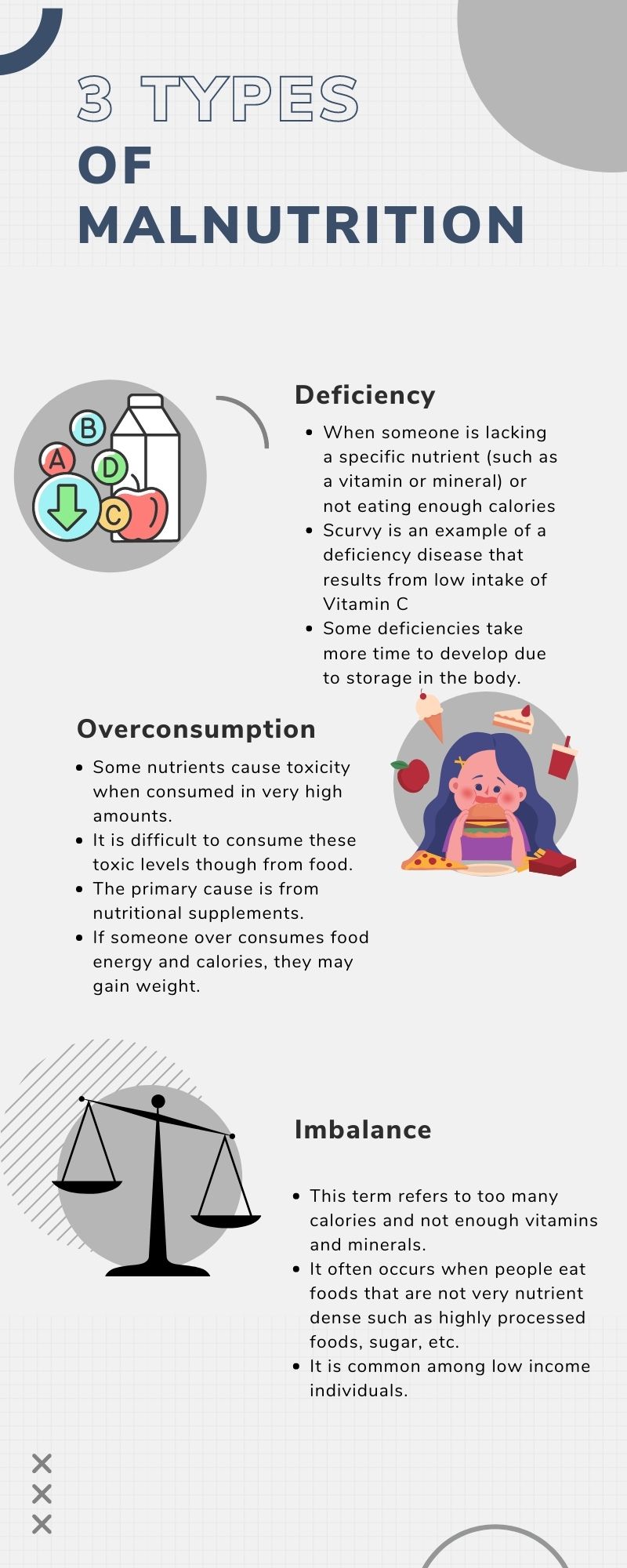1.2 Malnutrition
Figure 1.2 Three Types of Malnutrition

The terms malnourishment or malnutrition come from the Latin root word “mal” which means “bad” or “evil.” While many people think of malnutrition as a state of starvation or deficiency, it really means “bad” nutrition or a poor diet. Starvation or deficiency is one type of malnutrition, but there are other forms of malnutrition as well. Overconsumption of calories or specific nutrients and an imbalance of nutrients are also considered malnutrition. Both deficiency and overconsumption can happen with either specific nutrients (often vitamins and minerals) or food energy (calories).
- Deficiency: As the name implies, deficiency is when an individual is lacking a specific nutrient or sufficient calories for a period of time. Not consuming enough of a specific nutrient can lead to a deficiency disease. Deficiency diseases can often be reversed by adding the missing nutrient back to the diet. Some nutrients are stored in the body so deficiency takes more time to develop but other nutrients are not stored to any great extent and deficiency of those nutrients can occur more quickly. Iron deficiency anemia is one example of a deficiency disease. Iron is a mineral that is involved in oxygen transport in the blood and tissues. The fatigue and exhaustion that are often seen as a result of iron deficiency anemia are due to the body not having enough iron to transport adequate amounts of oxygen which is required for aerobic metabolism. Adding more iron rich foods or supplements can reverse iron deficiency anemia. Other examples of deficiency diseases include scurvy (vitamin c deficiency), rickets or osteomalacia (vitamin d deficiency), and osteoporosis (calcium deficiency). An individual can also suffer from a deficiency of calories or food energy. Short term, this leads to weight loss but a severe or prolonged energy deficiency can lead to muscle wasting and starvation.
- Overconsumption: Some nutrients can cause toxicity when consumed in very high amounts. However, it is difficult to consume toxic levels of vitamins and minerals from food. The primary method of overconsuming specific nutrients is taking supplements. Some nutrients are stored in the body and can accumulate to toxic levels over time if taken in larger than recommended amounts. With others, toxicity can occur from a single large dose. If an individual over consumes food energy or calories, or eats more calories than their body requires, they will gain weight. The exact amount of food energy required by a person is very individualized. We will discuss how to estimate an appropriate number of calories for your body later this semester.
- Imbalance: The term imbalance generally refers to too many calories and not enough vitamins and minerals. However, it can also refer to an imbalance of micronutrients if a person eliminates certain food groups from the diet. Imbalance often occurs when people eat foods that are not very nutrient dense. This includes highly processed foods that contain fat, sugar, and calories but very few other nutrients like protein, vitamins, minerals, and fiber. Imbalance is common among low income individuals. Healthy foods are often more expensive than empty calorie processed foods and, in some areas, fresh food may not even be available. While there are many options for healthy, budget friendly foods, many people lack the education to know what processed or shelf stable foods are good sources of nutrients. When a family lacks money, they often choose foods that provide them with the greatest number of calories and the lowest cost. So even though the individual may be “overfed,” they are still “undernourished.”
Media Attributions
- 3 Types of Malnutrition © Natalie Fox is licensed under a CC BY (Attribution) license
